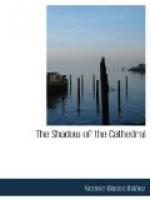INTRODUCTION
There are three cathedrals which I think will remain chief of the Spanish cathedrals in the remembrance of the traveller, namely the Cathedral at Burgos, the Cathedral at Toledo, and the Cathedral at Seville; and first of these for reasons hitherto of history and art, and now of fiction, will be the Cathedral at Toledo, which the most commanding talent among the contemporary Spanish novelists has made the protagonist of the romance following. I do not mean that Vincent Blasco Ibanez is greater than Perez Galdos, or Armando Palacio Valdes or even the Countess Pardo-Bazan; but he belongs to their realistic order of imagination, and he is easily the first of living European novelists outside of Spain, with the advantage of superior youth, freshness of invention and force of characterization. The Russians have ceased to be actively the masters, and there is no Frenchman, Englishman, or Scandinavian who counts with Ibanez, and of course no Italian, American, and, unspeakably, no German.
I scarcely know whether to speak first of this book or the writer of it, but as I know less of him than of it I may more quickly dispatch that part of my introduction. He was born at Valencia in 1866, of Arragonese origin, and of a strictly middle class family. His father kept a shop, a dry-goods store in fact, but Ibanez, after fit preparation, studied law in the University of Valencia and was duly graduated in that science. Apparently he never practiced his profession, but became a journalist almost immediately. He was instinctively a revolutionist, and was imprisoned in Barcelona, the home of revolution, for some political offence, when he was eighteen. It does not appear whether he committed his popular offence in the Republican newspaper which he established in Valencia; but it is certain that he was elected a Republican deputy to the Cortes, where he became a leader of his party, while yet evidently of no great maturity.
He began almost as soon to write fiction of the naturalistic type, and of a Zolaistic coloring which his Spanish critics find rather stronger than I have myself seen it. Every young writer forms himself upon some older writer; nobody begins master; but Ibanez became master while he was yet no doubt practicing a prentice hand; yet I do not feel very strongly the Zolaistic influence in his first novel, La Barraca, or The Cabin, which paints peasant life in the region of Valencia, studied at first hand and probably from personal knowledge. It is not a very spacious scheme, but in its narrow field it is strictly a novela de costumbres, or novel of manners, as we used to call the kind. Ibanez has in fact never written anything but novels of manners, and La Barraca pictures a neighborhood where a stranger takes up a waste tract of land and tries to make a home for himself and family. This makes enemies of all his neighbors who after an interval of pity for the newcomer in




